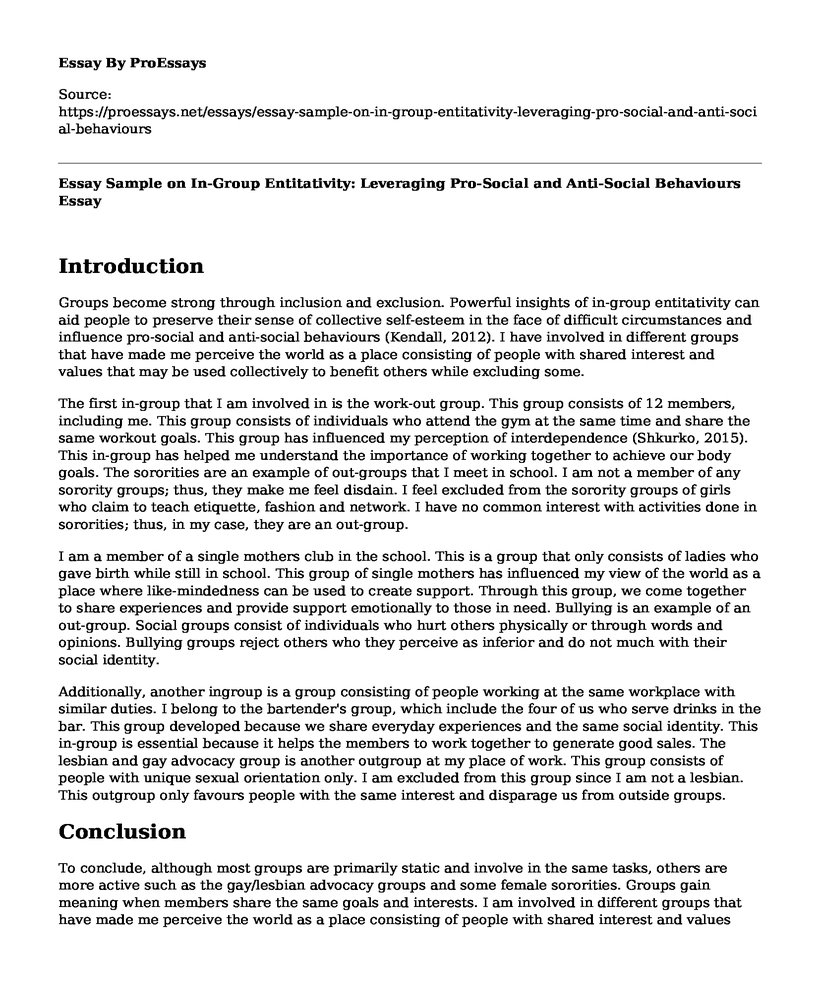Introduction
Groups become strong through inclusion and exclusion. Powerful insights of in-group entitativity can aid people to preserve their sense of collective self-esteem in the face of difficult circumstances and influence pro-social and anti-social behaviours (Kendall, 2012). I have involved in different groups that have made me perceive the world as a place consisting of people with shared interest and values that may be used collectively to benefit others while excluding some.
The first in-group that I am involved in is the work-out group. This group consists of 12 members, including me. This group consists of individuals who attend the gym at the same time and share the same workout goals. This group has influenced my perception of interdependence (Shkurko, 2015). This in-group has helped me understand the importance of working together to achieve our body goals. The sororities are an example of out-groups that I meet in school. I am not a member of any sorority groups; thus, they make me feel disdain. I feel excluded from the sorority groups of girls who claim to teach etiquette, fashion and network. I have no common interest with activities done in sororities; thus, in my case, they are an out-group.
I am a member of a single mothers club in the school. This is a group that only consists of ladies who gave birth while still in school. This group of single mothers has influenced my view of the world as a place where like-mindedness can be used to create support. Through this group, we come together to share experiences and provide support emotionally to those in need. Bullying is an example of an out-group. Social groups consist of individuals who hurt others physically or through words and opinions. Bullying groups reject others who they perceive as inferior and do not much with their social identity.
Additionally, another ingroup is a group consisting of people working at the same workplace with similar duties. I belong to the bartender's group, which include the four of us who serve drinks in the bar. This group developed because we share everyday experiences and the same social identity. This in-group is essential because it helps the members to work together to generate good sales. The lesbian and gay advocacy group is another outgroup at my place of work. This group consists of people with unique sexual orientation only. I am excluded from this group since I am not a lesbian. This outgroup only favours people with the same interest and disparage us from outside groups.
Conclusion
To conclude, although most groups are primarily static and involve in the same tasks, others are more active such as the gay/lesbian advocacy groups and some female sororities. Groups gain meaning when members share the same goals and interests. I am involved in different groups that have made me perceive the world as a place consisting of people with shared interest and values that may be used collectively to benefit others.
References
Kendall, D. (2012). Sociology in our times. Cengage Learning.
Shkurko, A. V. (2015). Cognitive mechanisms of ingroup/outgroup distinction. Journal for the Theory of Social Behaviour, 45(2), 188-213.
Cite this page
Essay Sample on In-Group Entitativity: Leveraging Pro-Social and Anti-Social Behaviours. (2023, Jan 24). Retrieved from https://proessays.net/essays/essay-sample-on-in-group-entitativity-leveraging-pro-social-and-anti-social-behaviours
If you are the original author of this essay and no longer wish to have it published on the ProEssays website, please click below to request its removal:
- Research Paper on Strategic Communication in Project Management
- Tangible and Intangible Resources Possessed by Ford Paper Example
- Groupthink by Irving Janis Paper Example
- Essay on Preventing Workplace Violence: What I Learned at the Conference
- Essay on SmartTech Consultants: 5-Year Strategic Plan for Up-Scaling & Quality Service
- Paper Example on Leadership: Strategies for Successful People Management
- Essay Example on BSN Sports: Corporate Strategies for Distribution & Marketing of Sports Equipment







